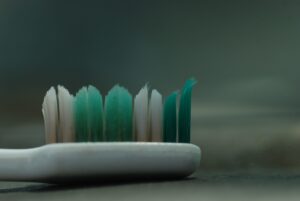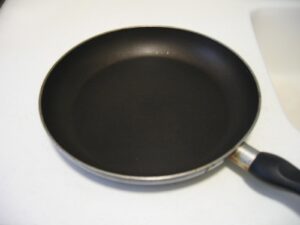 I spoke on Monday about tooth brushing and cleaning. Part of the reason for doing this is that I have had some persistent gum erosion and tooth sensitivity, and I wanted to determine if nylon fibres, with their possible isothiazolinone contamination were at least partially to blame. Nylon is used as the bristles in most modern toothbrushes and is one of the two main dental floss materials. Today I’d like to continue my previous discussion with some information I’ve learned about floss.
I spoke on Monday about tooth brushing and cleaning. Part of the reason for doing this is that I have had some persistent gum erosion and tooth sensitivity, and I wanted to determine if nylon fibres, with their possible isothiazolinone contamination were at least partially to blame. Nylon is used as the bristles in most modern toothbrushes and is one of the two main dental floss materials. Today I’d like to continue my previous discussion with some information I’ve learned about floss.
I used to use the typical waxed floss that you would get from your dentist. I have tight teeth, but I just shredded it and moved on, flossing again if the floss broke and things got stuck. That all changed when my university roommate, “the dentist,” handed me a 100 meter dentist-sized sample roll of Glide floss. That stuff was glorious. It almost never broke between my teeth, never shredded, and slipped between my crowded teeth easily. When I ran out of that roll, I had to buy the mint version from the drug store, but I never looked back, until now.
Teflon
 When I mentioned to a friend about looking for alternate tooth cleaning materials, she mentioned floss and Teflon (PTFE, or polytetrafluoroethylene). It turns out that Teflon is becoming more and more common in floss. I had worked so hard to get Teflon out of my kitchen (aluminum pans are SO much easier to clean!) and ignored my bathroom. It turns out that Glide floss (now owned by Proctor and Gamble under their Crest/Oral-B brands) is made from Teflon. No wonder it slid between my cozy teeth easily. Further searches told me that flossing with Teflon-based products actually leaves small amounts of Teflon behind in your mouth.
When I mentioned to a friend about looking for alternate tooth cleaning materials, she mentioned floss and Teflon (PTFE, or polytetrafluoroethylene). It turns out that Teflon is becoming more and more common in floss. I had worked so hard to get Teflon out of my kitchen (aluminum pans are SO much easier to clean!) and ignored my bathroom. It turns out that Glide floss (now owned by Proctor and Gamble under their Crest/Oral-B brands) is made from Teflon. No wonder it slid between my cozy teeth easily. Further searches told me that flossing with Teflon-based products actually leaves small amounts of Teflon behind in your mouth.
Why should I care about a little bit of Teflon? It’s pretty common knowledge now that scratched Teflon-coated pans release carcinogenic substances into the food cooked on them. Teflon is so normalized in our lives that most people don’t worry about that. The issue with Teflon goes much deeper than that.
Teflon was traditionally made with a chemical called PFOA, or perfluorooctanoic (per-floor’-oh-okt-an-oh’-ik) acid, also known as C8. Teflon was first invented in 1938. In 1954 the first concerns about PFOA toxicity were expressed by DuPont employees. Its toxicity was confirmed internally by DuPont in 1961. Since then, DuPont has released thousands of pounds of PFOA into the Ohio River and the air, limits in drinking water were increased, lawsuits for death of livestock and poor health/high cancer rates/high developmental issues rates/high birth defects in local communities were settled, and health effects including reproductive defects and toxicity, cancer, and liver toxicity were identified. PFOA accumulates in the bodies of humans and other animals. PFOA has been shown by the Environmental Working Group (EWG) to be released from Teflon-coated pans during regular use, even with no pan damage. DuPont agreed to phase out the use of PFOA in making PTFE by 2015, but there is no evidence that the chemicals that have replaced PFOA are safer. PTFE itself has been linked to hormone disruption, cancer, low birth weights, and brain and liver problems.
What are the alternatives?
 I did not want to keep tying myself to that kind of material, forcing exposure. I considered other kinds of floss, but the other main kind of floss is made from nylon, which is a potential isothiazolinone exposure risk (through the oils used to lubricate the fibre through the manufacturing process). I also want to avoid flavoured floss to limit propylene glycol exposure. I do use a small metal hook to get large food particles out from between my teeth, but that can erode teeth slightly over time, and I needed something more thorough.
I did not want to keep tying myself to that kind of material, forcing exposure. I considered other kinds of floss, but the other main kind of floss is made from nylon, which is a potential isothiazolinone exposure risk (through the oils used to lubricate the fibre through the manufacturing process). I also want to avoid flavoured floss to limit propylene glycol exposure. I do use a small metal hook to get large food particles out from between my teeth, but that can erode teeth slightly over time, and I needed something more thorough.
One great flossing option for allergy sufferers is a Water Pic system. These systems use a high-pressure jet of water to blast food particles and plaque from between teeth. These systems typically cost between $60 and $150. Not in my budget at the moment.
I finally decided to try silk floss. In the local stores, silk dental floss sells for $14 per 33 yards, but Amazon.ca had Radius Natural Silk Floss (unflavoured) for $7 per roll. Not ideal, but I figured that I could be stingy with it. I decided to buy two. I also found this brand from Life Without Plastic, but that would have to wait until I could place a bigger order. It’s also more than twice the cost of the Radius floss, although it does have the benefit of coming in a (reusable?) metal tin rather than a plastic case (recycling symbol 5). Another difference is that the Radius floss is coated in candelilla wax whereas Le Negri floss is coated in beeswax. Radius sells a vegan floss as well, but that is made of nylon and is flavoured.
 The Radius silk floss is has no flavour and very little smell. It is round in profile, which can make it a bit more challenging to get between my overly-friendly teeth than the Glide. It seems to rub against the side of my teeth nicely and is gentle on the gums. I did encounter a bit of problem with a few of my tighter teeth. The floss shreds over time, and it broke once while I was trying to pull it out of my teeth. I had to floss with a new piece to get the broken bit out because it was really stuck in there. Some people said they had good luck with twisting two strands together and flossing with the doubled strand, but in the interests of stretching out the floss’s use (and not sticking even bigger things between my very-close-together teeth), I have not tried that.
The Radius silk floss is has no flavour and very little smell. It is round in profile, which can make it a bit more challenging to get between my overly-friendly teeth than the Glide. It seems to rub against the side of my teeth nicely and is gentle on the gums. I did encounter a bit of problem with a few of my tighter teeth. The floss shreds over time, and it broke once while I was trying to pull it out of my teeth. I had to floss with a new piece to get the broken bit out because it was really stuck in there. Some people said they had good luck with twisting two strands together and flossing with the doubled strand, but in the interests of stretching out the floss’s use (and not sticking even bigger things between my very-close-together teeth), I have not tried that.
I do wonder if perhaps one could make their own silk dental floss if they obtained some undyed stranded silk, twisted, and rubbed it across a piece of beeswax. If you wanted to get the floss under an appliance, you might be able to soak the end of the floss in a sugar or starch mixture and let it dry stiffly (add extra beeswax to stiffen even more). Just make sure to floss *before* you brush. For those who like puffy floss, stranded floss does get more “fuzzy” as you go along, especially if you only wax it lightly. This may be a project for another day.
I would like to try the LeNegri floss, but I can’t justify the expense right now. I won’t say the Radius floss is perfect, but it’s the best fit for my needs at this time (unless someone wants to send me some other silk dental floss or a Water Pic to review). I’ll keep using it until something better comes along.
Have you tried nylon-free and Teflon-free floss? What did you try? How did it work for you? Do you have another method of cleaning between your teeth? Comment below.

I use the radius floss because I also threw out all teflon pans after learning of the C8 teflon catastrophe. I read the amazing and alarming article “Welcome to Beautiful Parkersburg West Virginia ” -thank you for linking floss and teflon as a noteable daily use product hazard .